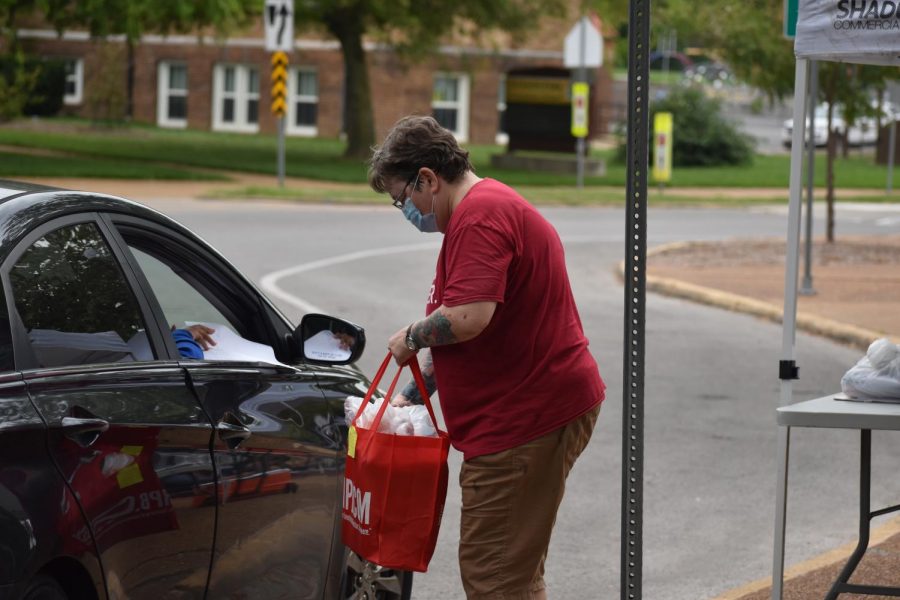Your donation will support the student journalists of University City High School - MO. Your contribution will go towards our young journalism events such as Media Passes, Sports Game Tickets, And equipment for our students.
A safer alternative
October 29, 2020
Peggy Halter, English teacher, hands out books to students in her literature classes during a drive-through school supply pickup in September.
It would be downright irresponsible to send high school students back at this point. Even in Kirkwood, Parkway and Clayton, substantial backlash resounded from students surrounding the concerns of in-person learning during a pandemic, and those concerns are not confined to those areas. At a time when COVID-19 cases are surging—especially in high-school-age demographics—the choice of these districts to funnel their students back into a potentially hazardous environment makes absolutely no sense. The desire to achieve normalcy is never satisfied by jamming a warped version of reality—in this case, one that disregards prominent scientific research—down the throats of those who will be most affected. It is utterly foolish for those districts to succumb to the pathetic egging-on from complaining parents. It is fatally hypocritical for districts to push STEM fields onto students and then fundamentally ignore every aspect of evidence-based-thinking.
If COVID-19 is getting worse, why are we now deciding to take haphazard risks? It’s an issue that has been exacerbated politically and goes against every elementary fundamental principle that schools feed their students. We don’t manipulate the data to fit our hypothesis. We don’t ignore subsets of our population when we send out polls. So why are our leaders? Why am I afraid that the people in charge are more concerned about the opinions of the parents than of the students who will have to sit in class?
I won’t sit here and claim that online school doesn’t suck, but I certainly will not heed an inch to my own concerns about potentially going back into the building. I don’t feel good about it, and I know that most of my peers, when not overtaken by the crippling desire to feel connected to our school community, feel the same. I know how I am, how teenagers are. I see large gatherings of high schoolers on social media, birthday parties with maybe a single mask-wearing attendee, signs that people my age don’t care to take precautions. Beyond those conscious choices, I know peers who have to work through the pandemic at jobs where they interact with an enormous amount of people. I, myself, go out into public; I wear a mask, of course; I completely avoid crowds, even small ones; I only see one or two people with any regularity outside of my immediate family, I don’t eat inside of restaurants and I follow physical-distancing with anyone I don’t see daily. But even that, which represents a fairly conservative approach to a pandemic, presents a more-than-considerable approach to a pandemic when multiplied across an entire school population. I take all of the necessary precautions, but there are too many people to keep track of, too many potential sources of an outbreak, too many variables that make a return to school impossible to accomplish even relatively safely. Add in the fact that teenagers are notoriously guilty of flouting guidelines and it’s not difficult to see the problem with shoving high schoolers back in school prematurely.
Ultimately, this pandemic and the resulting solutions rest on the unknowns, and there are far too many to feel confident in a return plan. One of the largest criticisms from returning students to their districts was a lack of communication between the decision makers and those affected, and U. City students certainly can relate to that. Even with no plans for returning on the horizon, the criticism sourced from other high schools offers a unique opportunity for our own district to do better, and they can start by hearing student concerns surrounding distance learning. Many students, myself included, feel overwhelmed and drained from virtual learning, but recognize that it is the only truly safe option. I haven’t talked to a single person—student or teacher—who doesn’t feel that their workload has increased significantly online than it is in person. We have to stay in the same setting for work all day. Our once bustling and stimulating school days have been replaced with mundane, blue-light simulations. I also haven’t talked with anyone so adamant about going back that they feel these issues are without solutions—and that is why we need our input to be heard. We don’t want to go back, we simply want our concerns about distance learning to be listened to and addressed. Since the first week of school, students have not received a single survey from any district or school administration, which is—quite frankly—unacceptable. If students are taught how to persevere through challenges in the classroom, then the adults in charge of the standards for learning need to adhere to the same principles. A plan is never perfect; it requires constant attention and attending to. Our current learning model is far from perfect, but it would likely benefit from a conscious effort to recognize its issues.
I am confident that if distance learning was tweaked to better suit the reservations of those within it, there would be no need to return to school. Therein lies the key point. These circumstances are not about what everyone wants—because we all want to go back to normal. It’s about what we need to do—and right now we need to continue on the path we’ve set out upon and improve the quality of online education.

